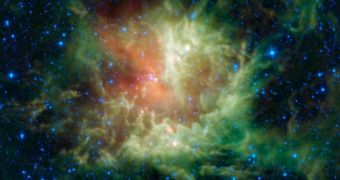A large stellar nursery known as the Pacman Nebula is revealing new aspects of itself to astronomers in this infrared image captured by the NASA Wide-field Infrared Survey Explorer (WISE). The teeth-like structures visible in Pacman's mouth are not visible in visible-light wavelengths.
According to astronomers, it could be that these formations are in fact areas where intense stellar formation is taking place, the place where young, blue stars are born. In optical wavelengths, these protostars are covered by large volumes of dust and gas, which obscure their brightness.
When viewed in normal light, the Pacman Nebula displays its typical, triangle-shaped mouth. When an IR filter is applied, suddenly fangs appear. Scientists now believe that the “teeth” were produced by stellar winds and radiations emanating from the massive stars in the nursery.
The astronomical name for the nebula is NGC 281. It lies about 9,200 light-years away from Earth, in the direction of the constellation Cassiopeia, say experts at the NASA Jet Propulsion Laboratory, who managed the WISE mission.

 14 DAY TRIAL //
14 DAY TRIAL //